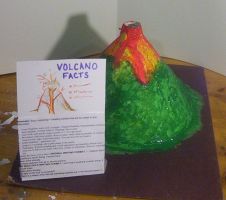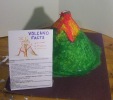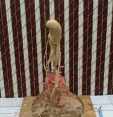How to Make a Volcano For School
So you need to make a volcano as a school project. I have some great tips and tutorials here that will help you do really good on your school project. There are some important things to think about when you are making a volcano. First off this is a learning project and it will help you learn a few different things.
You will learn how a volcano works, you will learn a little bit about chemical reactions, and you will learn how to make something.
1. Make it a learning tool so you can show what you learned and teach others
 The first thing you should think about is how a volcano works and how you will describe this in your project. You should do some research on volcanos and how they work but I also have something that will help a lot. On the back of my volcano I attach a sheet that shows the various parts of the volcano and how a volcano erupts. You can print it up and use it for your volcano. It is Here so you can print it out
The first thing you should think about is how a volcano works and how you will describe this in your project. You should do some research on volcanos and how they work but I also have something that will help a lot. On the back of my volcano I attach a sheet that shows the various parts of the volcano and how a volcano erupts. You can print it up and use it for your volcano. It is Here so you can print it out If you don't want to attach the sheet to the back of your project you can make a fact sheet to attach to the front like this one:

You can print up my vocano fact sheet shown above or you can make your own fact sheet and do your own drawing. The important thing is that you do a little bit of research so you understand the major points of a volcano and then write these major points on your sheet. Now your volcano isn't just a fun project, it's a fun learning and teaching project. Now other people can learn from it too.
2. The Chemical Reaction of Baking Soda and Vinegar:
Vinegar is an acid, and baking soda is a base. When you mix the two you get an acid base reaction.What happens is that the end result of this mixing creates something called Carbonic Acid. This Carbonic Acid quickly decomposes into carbon dioxide and water. The carbon dioxide (CO2) is what causes the bubbling in the water. Here is a look at it:
Vinegar is acetic acid: CH3COOH Baking soda is sodium bicarbonate: NaHCO3 Mixing the two is an acid base reaction. CH3COOH + NaHCO3 --gives you---> CH3COONa + H2CO3 That last product is carbonic acid which quickly decomposes into carbon dioxide and water: H2CO3 ---> H2O + CO2 The CO2 is what you see foaming and bubbling in this reaction.
3. Now let's make our volcano
I have three different projects you can choose from: Paper mache (medium hard), Poster board (easy and fast), Plaster, Mentos and Diet Coke (Hard but spectacular). Each one of these volcano projects is a complete tutorial with a video. Paper Mache Volcano Project Here is a tutorial on how to make a volcano. I have several versions of the volcano so you can decide which type is best for you. There is the dough volcano, and the plaster of paris volcano, and the Papier Mache volcano. This way you can choose the tutorial that fits your needs and the materials you have on hand. Paper Mache Volcano
Paper Mache Volcano Project Here is a tutorial on how to make a volcano. I have several versions of the volcano so you can decide which type is best for you. There is the dough volcano, and the plaster of paris volcano, and the Papier Mache volcano. This way you can choose the tutorial that fits your needs and the materials you have on hand. Paper Mache Volcano  Posterboard Volcano Project I also have another volcano project you might be interested in. This project doesn't use any paper mache or plaster so it is much less mess, easier and faster to make and it looks great. It uses posterboard to form the cone of the volcano. The Easy Posterboard Volcano Project
Posterboard Volcano Project I also have another volcano project you might be interested in. This project doesn't use any paper mache or plaster so it is much less mess, easier and faster to make and it looks great. It uses posterboard to form the cone of the volcano. The Easy Posterboard Volcano Project 
Spectacular Mentos and Diet Coke Volcano I also have the Mentos and diet coke volcano which shoots a blast a foot or more into the air. This one is spectacular, easy to make but requires adult supervision. The Mentos Volcano
This activity is from:
http://www.stormthecastle.com/how-to-make-a/how-to-make-a-volcano-for-school.htm
page six
module ten